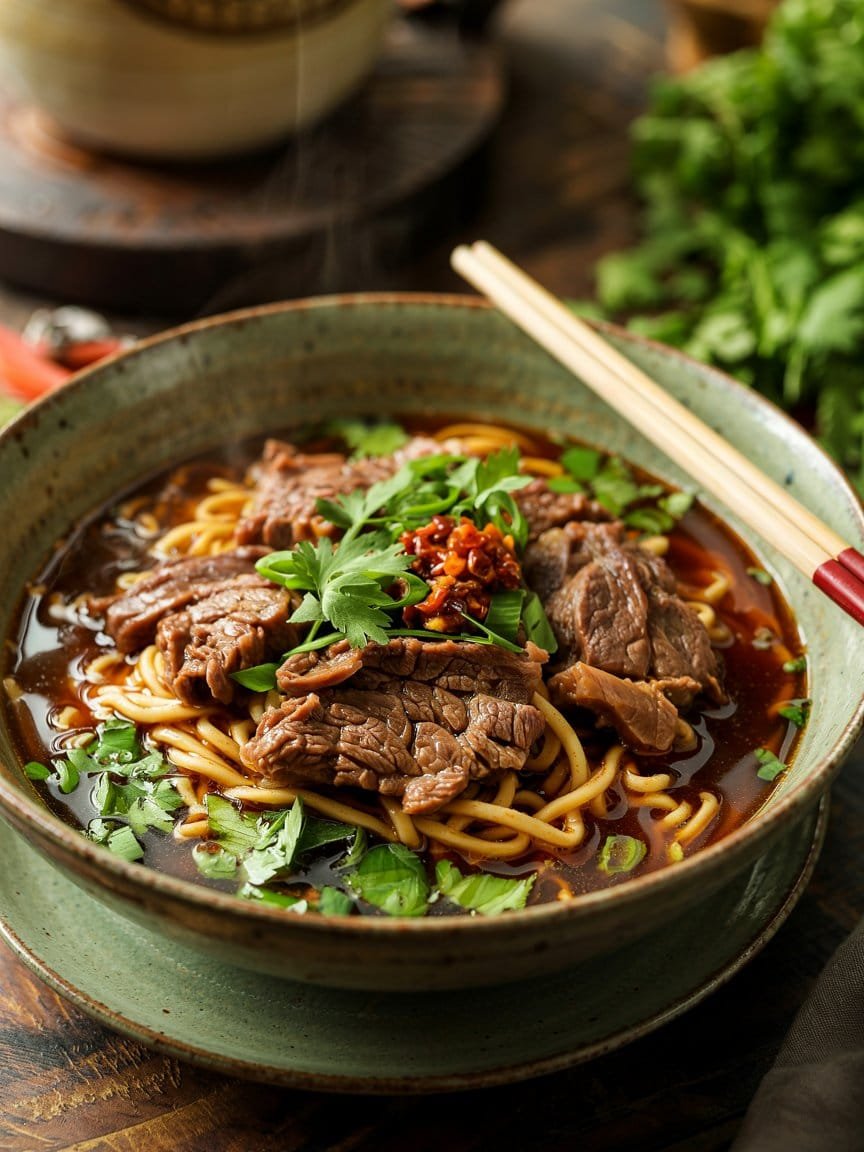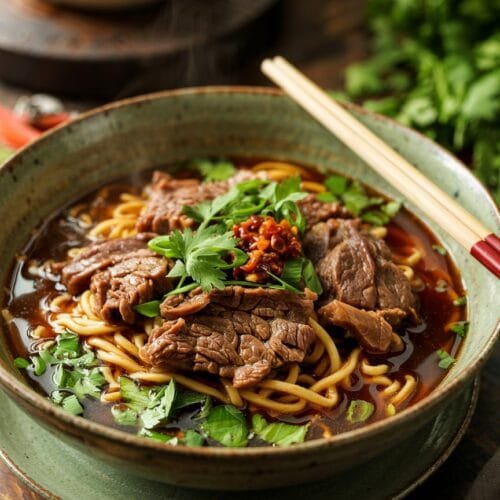Niu Rou Mian Taiwanese Beef Noodle Soup

If there’s one dish that captures the heart and soul of Taiwanese cuisine, it’s Niu Rou Mian, also known as Taiwanese Beef Noodle Soup. Revered as a national treasure, this comforting bowl of rich, fragrant broth, tender braised beef, and chewy wheat noodles is more than just a meal—it’s a cultural icon, often compared to ramen in Japan or pho in Vietnam.
As a professional chef with a deep love for East Asian culinary traditions, I’m excited to share with you not only how to make authentic Niu Rou Mian, but also the stories behind it, variations across regions, and tips to truly master this beloved dish.
What is Niu Rou Mian?
Niu Rou Mian (牛肉麵) translates directly to “beef noodle soup” in Mandarin. At its core, the dish consists of:
- A savory, aromatic broth
- Slow-braised chunks of beef, often shank or brisket
- Chinese wheat noodles, usually chewy and thick
- Pickled mustard greens and scallions for topping
But this simple description doesn’t do justice to the layers of flavor and culture packed into every spoonful.
What sets Taiwanese beef noodle soup apart is its fusion of Chinese, Taiwanese, and Sichuan influences, combining soy-based braising liquids with bold spices like star anise, ginger, and fermented bean paste.
The History and Cultural Significance of Taiwanese Beef Noodle Soup <a name=”history-and-culture”></a>
Although Niu Rou Mian is widely regarded as a Taiwanese dish, its roots can be traced back to the influx of mainland Chinese immigrants during the mid-20th century. Many of them brought their culinary traditions from various regions, especially Sichuan, and over time, these influences evolved into the unique Taiwanese version we know today.
Taiwan even hosts annual beef noodle soup competitions, where chefs across the country compete to create the most flavorful broth or the most tender beef. Locals often have fierce loyalty to their favorite shops—some swearing by rich, dark broths, others preferring lighter, clear versions.
Ingredients: What You’ll Need <a name=”ingredients”></a>
One of the beauties of Niu Rou Mian is its depth of flavor, achieved through layering and careful selection of ingredients.
For the Broth:
- 2–3 lbs beef shank or brisket, cut into large cubes
- 1 large onion, quartered
- 1 large tomato, quartered
- 1 bulb garlic, smashed
- 2-inch piece of ginger, sliced
- 4–5 scallions, chopped
- 2–3 star anise pods
- 1 small cinnamon stick
- 2 bay leaves
- 1 dried tangerine peel (optional but traditional)
- 8 cups water or unsalted beef broth
For the Braising Sauce:
- 3 tbsp soy sauce
- 3 tbsp dark soy sauce (adds deep color)
- 2 tbsp rice wine (Shaoxing wine preferred)
- 1 tbsp doubanjiang (fermented chili bean paste)
- 1 tbsp sugar (rock sugar if available)
Noodles and Garnishes:
- Chinese wheat noodles (thick or hand-pulled if possible)
- Pickled mustard greens (suan cai), rinsed and chopped
- Fresh scallions, sliced
- Cilantro (optional)
- Chili oil (for heat lovers)
Step-by-Step Recipe for Niu Rou Mian <a name=”recipe”></a>
This recipe yields about 4–6 generous servings and takes around 3–4 hours for the full experience, but most of that time is hands-off simmering.
Step 1: Blanch the Beef
Start by blanching your beef to remove impurities.
- Bring a pot of water to a boil.
- Add beef pieces and boil for 5 minutes.
- Drain and rinse the meat under cold water.
- Set aside.
Step 2: Prepare the Broth Base
In a large stock pot or Dutch oven:
- Heat a splash of oil and sauté onion, ginger, and garlic until aromatic.
- Add chopped tomato and stir until softened.
- Toss in your beef and lightly sear on all sides.
- Add soy sauces, rice wine, sugar, and doubanjiang.
- Stir to coat everything evenly.
- Pour in the 8 cups of water or beef broth.
- Add all remaining aromatics—star anise, cinnamon, bay leaves, and tangerine peel.
- Bring to a boil, then reduce to a simmer.
- Cover and braise for at least 2 to 2.5 hours, until beef is fork-tender.
Step 3: Cook the Noodles
- Boil noodles according to the package or make fresh if you’re ambitious.
- Rinse in cold water to halt cooking and improve texture.
Step 4: Assemble Your Bowl
- Place cooked noodles in a bowl.
- Ladle over beef and broth generously.
- Top with pickled greens, scallions, cilantro, and chili oil to taste.
Chef’s Tips and Tricks <a name=”tips-and-tricks”></a>
1. Cut of Beef Matters
Use beef shank for its gelatinous, collagen-rich texture. Brisket and short ribs also work well. You can even add beef tendon if you like a more traditional experience.
2. Don’t Rush the Braise
The magic happens during slow cooking. Give it time—2.5 to 3 hours minimum. If using a pressure cooker or Instant Pot, adjust time to about 45–60 minutes on high.
3. Layer Your Flavors
Frying aromatics before braising deepens the flavor. Don’t skip this.
4. Customize Heat and Salt
Taste your broth as it simmers and adjust soy sauce or sugar to balance saltiness and sweetness. Add more doubanjiang if you like it spicier.
5. Make It Ahead
In fact, Niu Rou Mian tastes better the next day. The flavors deepen as it sits overnight in the fridge.
Regional and Personal Variations <a name=”variations”></a>
Taiwanese families and restaurants have their own takes on beef noodle soup, making it an endlessly versatile dish.
1. Red Braised (Hong Shao) vs. Clear Broth
- Red-braised: Rich and dark, full of soy sauce and spices.
- Clear broth: Lighter, with fewer seasonings. Still flavorful, but milder.
2. Spicy vs. Mild
- Use extra doubanjiang or chili oil to add heat.
- Add Sichuan peppercorns for numbing spice if you enjoy mala flavor.
3. Vegetarian or Vegan Adaptation
- Use shiitake mushrooms, tofu, and vegetable broth.
- Sub in kombu and dried mushrooms for umami depth.
4. Hand-Pulled Noodles
Traditional restaurants often use hand-pulled noodles, but store-bought or homemade wheat noodles work just fine.
Serving Suggestions <a name=”serving”></a>
Here’s how to take your Niu Rou Mian from good to unforgettable:
- Side Dishes: Pair with cold cucumber salad, marinated tofu, or Taiwanese lu dan (soy eggs).
- Drink Pairings: Oolong tea, plum juice, or a crisp lager.
- Presentation: Serve in deep bowls with a sprig of cilantro and a drizzle of homemade chili oil for restaurant-style flair.
Storage and Make-Ahead Options <a name=”storage”></a>
Niu Rou Mian is a meal prep dream.
- Fridge: Store the broth and noodles separately. Keeps for up to 4 days.
- Freezer: Freeze the broth and beef for up to 3 months.
- Reheat: Gently reheat the broth on the stove. Add freshly cooked noodles for best texture.
Final Thoughts: Why Niu Rou Mian Deserves a Spot in Your Rotation <a name=”conclusion”></a>
Whether you’re seeking a cozy winter warmer or a new way to explore Taiwanese cuisine, Niu Rou Mian is more than worth the effort. It’s one of those dishes that, once you make it from scratch, you’ll never settle for takeout again. From its robust, spice-laden broth to its fall-apart beef and slurp-worthy noodles, every bowl tells a story of cultural fusion, comfort, and culinary tradition.
Give this Taiwanese beef noodle soup recipe a try—you might just find yourself with a new favorite. And don’t be afraid to make it your own. After all, that’s how the best recipes are born.

Niu Rou Mian Taiwanese Beef Noodle Soup
Ingredients
For the Broth and Beef:
- 2.5 to 3 lbs beef shank or brisket cut into large cubes
- 1 large onion quartered
- 1 large tomato quartered
- 1 bulb garlic smashed
- 2- inch piece of ginger sliced
- 4 –5 scallions chopped
- 2 –3 star anise pods
- 1 small cinnamon stick
- 2 bay leaves
- 1 dried tangerine peel optional
- 8 cups water or unsalted beef broth
For the Braising Sauce:
- 3 tbsp soy sauce
- 3 tbsp dark soy sauce
- 2 tbsp Shaoxing wine or rice wine
- 1 tbsp doubanjiang fermented chili bean paste
- 1 tbsp rock sugar or regular sugar
For Serving:
- Chinese wheat noodles fresh or dried
- Pickled mustard greens suan cai, rinsed and chopped
- Fresh scallions sliced
- Cilantro optional
- Chili oil to taste
Instructions
Step 1: Blanch the Beef
- Bring a pot of water to a boil.
- Add the beef cubes and boil for 5 minutes.
- Drain and rinse the beef under cold water to remove impurities. Set aside.
Step 2: Sauté Aromatics and Build Broth
- In a large pot, heat a splash of oil.
- Sauté the onion, garlic, and ginger until fragrant (2–3 minutes).
- Add the tomato and cook until softened.
- Add the beef and sear lightly on all sides.
- Stir in soy sauces, Shaoxing wine, sugar, and doubanjiang to coat evenly.
Step 3: Simmer
- Add 8 cups of water or beef broth and bring to a boil.
- Toss in star anise, cinnamon stick, bay leaves, tangerine peel, and scallions.
- Reduce to a simmer, cover, and cook for 2.5–3 hours, until beef is fork-tender.
Step 4: Prepare Noodles
- Cook noodles according to package instructions.
- Rinse under cold water to stop cooking and maintain texture.
- Step 5: Assemble and Serve
- Place noodles into serving bowls.
- Ladle over hot beef and broth.
- Top with pickled mustard greens, scallions, cilantro, and chili oil to taste.
- Serve hot and enjoy!
Notes
- Beef Cuts: Beef shank provides the best flavor and texture, but brisket, chuck, or short ribs work as well. For a more traditional version, add beef tendon.
- Storage: Store broth and noodles separately. Soup keeps in the fridge for up to 4 days or freeze for 3 months. Flavors deepen after a day!
- Vegetarian Option: Substitute beef with tofu or mushrooms, and use mushroom broth for depth.
- Make It Spicier: Add more doubanjiang, chili oil, or a touch of Sichuan peppercorns for a spicy kick.
